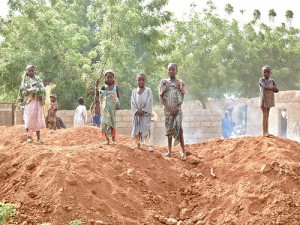
Children at the site of the world’s worst outbreak of lead poisoning in Nigeria
The CDC recently lowered the recommended limit for lead exposure in young children from 10 micrograms of lead per deciliter of blood, to 5. This means that lead levels above 5 ug dl in children will now be considered unsafe.
What’s interesting is that according to a CDC spokesperson, “…as we remove lead from the environment, it’s expected that this reference level will be going down, because we still want to be identifying children at the highest levels.”
So as the number of children in the U.S. with unsafe lead levels fall and we come closer to eliminating childhood lead poisoning in this country, perhaps we might see the CDC tolerance for lead in young children drop to zero since, really, no level of lead is considered safe in children.
What this tightening of lead standards exposes is the great divide between children in the U.S. and those in some of the world’s worst polluted places.
Lead poisoning accounts for at least 0.6% of the global burden of disease (WHO, 2009). Blacksmith considers it one of the world’s worst pollution problems. The problem is pretty much contained in the U.S., where much of the risk from lead comes from old lead paint and plumbing in houses built before 1978, as well as some imported products that escape inspection. But in countries where there is little regulation, the lead numbers registered in children tell a devastating story.
Keeping in mind that levels around 45 ug dl are considered acute, take a look at some of these figures we’ve come across.
- In Haina in the Dominican Republic, a hotspot of lead contamination because of improper battery recycling, we have seen blood lead levels as high as 234 ug dl.
- In 2009, a lead poisoning outbreak in Senegal went undetected until 18 children died. The highest lead levels recorded in children between one and five years-old was 158 ug dl.
- In Nigeria, the high price of gold prompted a mini gold rush in 2010, and villagers took to mining the lead-rich ore. This resulted in the world’s worst outbreak of lead poisoning. Over 400 children were killed. Lead levels as high as 150 ug dl were recorded. (see photos)
- In Mexico, where many of the country’s 50,000 potters use toxic lead-based glazes, we found 10-year old twins Lupita and Juan with blood lead levels of 20 and 27 ug dl respectively. They are typical of the children in these artisan communities.
In all the above examples, blood lead levels in the children dropped dramatically after remediation efforts. But even if we achieve 50% decreases, none of the children will reach the new U.S. standard of 5 ug dl.





